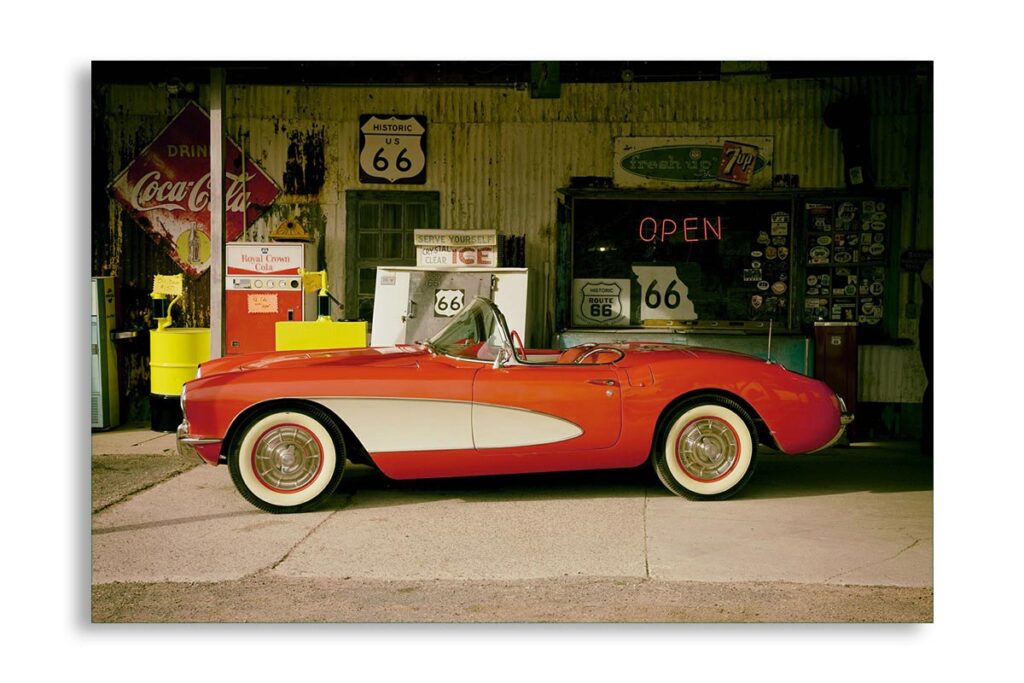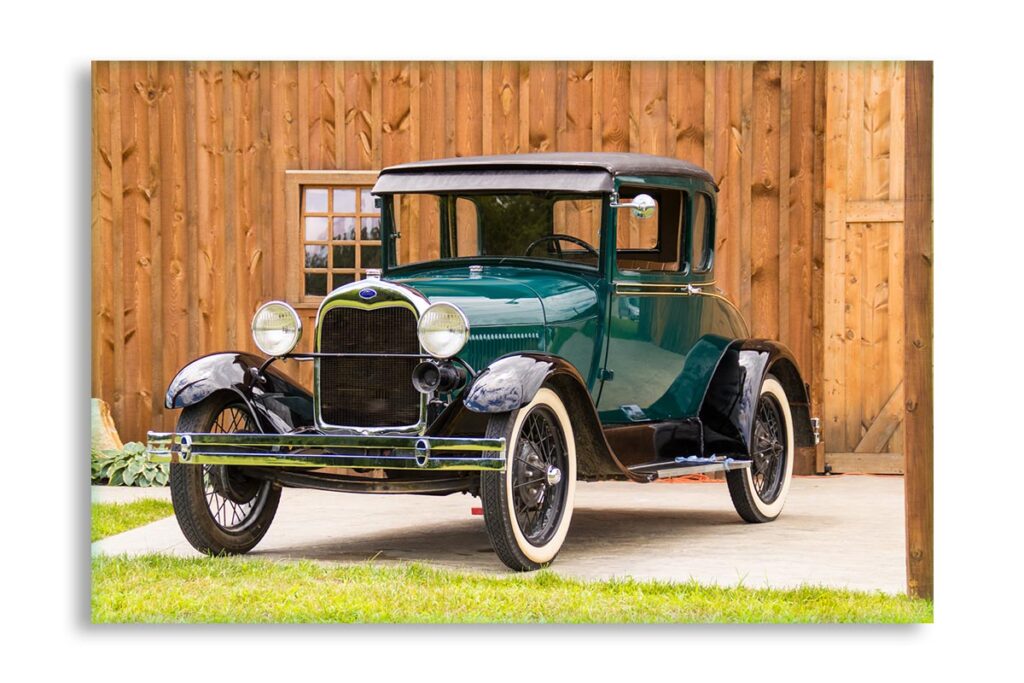
Photo Car.
Since you may want to photograph a car for many reasons, let’s put ourselves in the situation that what you want is to sell it (literally or metaphorically), or at least that you want to photograph it in all its perfection.
What you are looking for is to enhance its beauty, its strength, etc. Because if you’re looking to tell the story of rust, iron, abandonment, and abandonment, some tips won’t help you.
Photographing.
Photographing a car can be challenging due to its large dimensions. That is why a favorable environment that makes it stand out from the bottom is essential. It is not the same to take a few photos parked on your street among a few more cars, with some works next door, the parking meter, and people walking along the street, to take your impeccable car and take it to a suggestive environment, where you can isolate it from so much element and make it stand out. In the middle of a meadow, with a beach at the bottom, a forest, or even a smooth or cobblestone wall, according to your possibilities or the possibilities of your environment.
Choose a suitable environment.
It is no secret what a good cleaning and wax hand can do to the appearance of a car. As old or bland as it may seem to you, the truth is that a vehicle in perfect cleaning conditions increases the positive impression of it by a few points. So if you want to portray your car’s wonders, make it impeccable.
Note: If it is so clean and shiny that you could shave looking at your body, you may need a polarizing filter to eliminate glare and glare.
Or, on the contrary, you can squeeze your artistic vein by playing with the reflections of the sky in certain parts of the car.

Telephoto Lens.
Make sure the car is impeccable.
Are you lucky to have several focal points but need help knowing where to start? Well, take advantage of the sensations that different optics can convey:
Wide Angle: It is the one that has the most significant portion of the environment. If the domain is worth it, this is the landscape’s star goal. In addition, from the point of view close to the objective, it creates distortions that can be very interesting to enhance the lines or certain aspects of the car.
50mm: It is the one that most resembles the human eye. Suppose you have the King of the objectives, in addition to sharpness. In that case, you will have great luminosity and a versatile dream for all shots, from general plans to interior or exterior details.
Telephoto lens: Its main characteristic is to approach the scene thanks to the wide focal length, flatten the image, and isolate it from the background due to its reduced depth of field.
Flat Image.
Regardless of your focal point, if you want to avoid boring images, you must go beyond seeing, aiming, and shooting. Once you have a few good pictures with general information about the car (front, rear, and side), try to modify the point of view. From bottom to top (counter-chopped), from top to bottom (chopped), and so on. You will see how the perspective changes and the message you convey.
From a flat image, you can create a vital, daring, and much more exciting image simply by giving it another twist and testing new points of view.
Varying the point of view will offer you more exciting images.
Image Sharpness.
Try to keep the ISO as low as possible, as this is how you will maintain more excellent sharpness and have better image quality. Use a tripod to work with low ISO without causing image shaking if necessary.
Remember the importance of opening the diaphragm when playing with depth of field. With more open diaphragms, you will allow more light to enter, but you will work with reduced depths of field. On the contrary, the more you close the diaphragm, you will have light but with a greater depth of field (area focused on the image).
As a general rule, for the entire car to remain focused, you need to close the diaphragm at an approximate aperture of f / 8 or f / 11. From there, make several tests according to the type of image you want to achieve.
When photographing cars, the sky is expected to be part of the composition in most shots, especially if you have listened to me and taken your car to a somewhat more positive environment. If so, the contrast between the sky and your car is likely very high, and consequently, you can not expose well for the two lights. You have two ways to solve it:
Photographing.
With a neutral gradient filter. This filter, widely used in landscapes, reduces the entry of light into one of its halves, compensating and matching the exposures of the illuminated areas and the darkest areas (sky and earth)
Take a minimum of three exposures of the scene, one underexposing the image somewhat, another with normal measurement results, and another overexposing. A tripod is highly recommended to merge the three images correctly using an editing program. This technique is what we call bracketing or bracketing.
Unleash your creativity by photographing the different details of the car: the tires, the gearshift, the dashboard, the rear lights … Play with the depth of field to highlight the center of interest by blurring the background (large openings), and so on. If the environment is pleasant, play to integrate it from the inside, through the mirrors, the windows, and so on.
Detail with and without polarizing filters and proof of the importance of a clean car
We have already commented that you may not find the perfect environment when you get ready to photograph your car. The best way to ensure good shots is to do your best on-site. However, small tweaks are often challenging to achieve without some processing. If you shoot in RAW, these small adjustments your image may need will allow you to maintain the highest quality.
Image Contrast.
It allows small adjustments of light, contrast, saturation, sharpness, etc., without the image quality suffering.
Allows you to modify the white balance at your leisure
The images are stored in “raw” (RAW) and keep all available raw information, which means that all processing decisions are yours, but at the same time, the images weigh much more than other storage formats. Keep that in mind before you shoot like crazy.
Photography Composition.
Sunrises, sunsets, golden hours, and blue hours will be great allies in empowering the environment and taking advantage of the most flattering hours of the day. You can play with the exterior light and add the car’s lights. Unleash the imagination and take advantage of the best of both lights. In an urban environment, you can take advantage of street lamps and reflections or play with the bokeh … Even the night can hold fascinating and unique images.
Take advantage of the surrounding lights to enhance the image.
Do not just “put” the car into the frame in any way. Composition is always essential. The law of the gaze or the rule of thirds may be helpful; A car is still an inanimate portrait, so you can apply the same rules as if it were a face.
Take care of the composition.
How about? Have you ever considered taking a few good pictures of your car? Did you want to sell it and didn’t know where to start? Do you wish to banter a new car? Whatever the reason for your interest in photographing cars, I hope this article has given you a few good tips to get started. If so, do us a favor and share it so that someone else can benefit from them. Thank you, and see you next time.
Author Profile

Latest entries
- August 19, 2024Photo PrintsHow to Clean Glass Pictures: Keep Your Memories Sparkling
- August 19, 2024Photo PrintsThe Best Photo Cameras of 2024
- August 19, 2024Photo PrintsAPG Graphics: The Only Company That Laminates Photos on Glass in the USA
- August 19, 2024Photo PrintsThe Best Online Photo Printing Services for 2024
